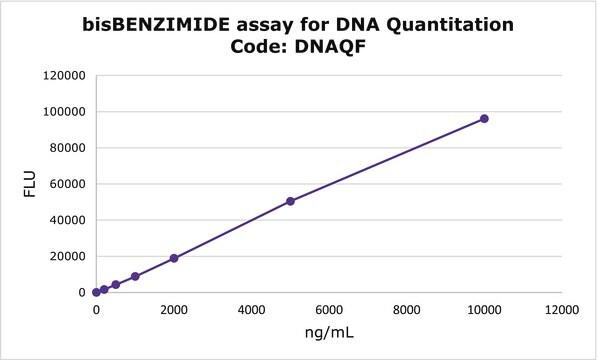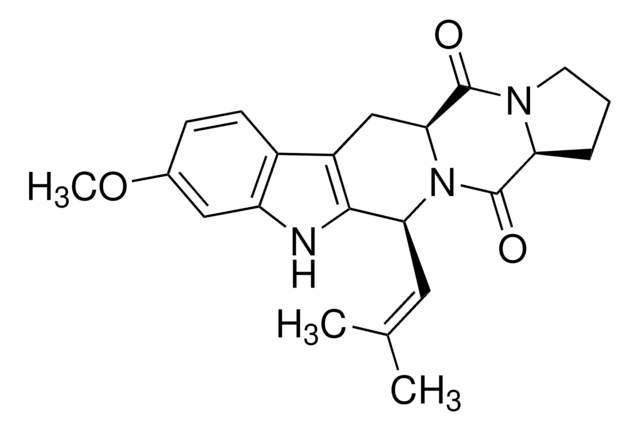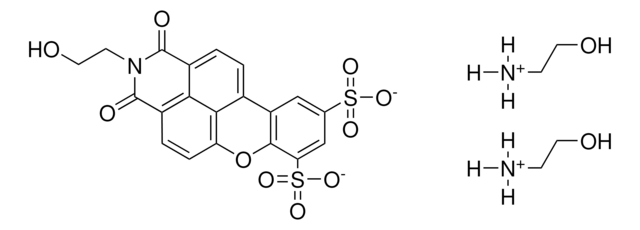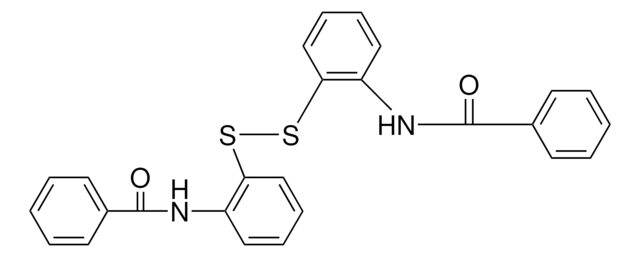B2261
bisBenzimide H 33342 trihydrochloride
≥98% purity (HPLC and TLC), powder
Sinonimo/i:
2′-(4-Ethoxyphenyl)-5-(4-methyl-1-piperazinyl)-2,5′-bi-1H-benzimidazole trihydrochloride, HOE 33342, Hoechst 33342, bisBenzimide
About This Item
Prodotti consigliati
product name
bisBenzimide H 33342 trihydrochloride, ≥98% (HPLC and TLC)
Livello qualitativo
Saggio
≥98% (HPLC and TLC)
Forma fisica
powder
Colore
yellow
pH
1.7 (20 °C)
Solubilità
H2O: 20 mg/mL
phosphate buffer: precipitates
Compatibilità
suitable for fluorescence
applicazioni
diagnostic assay manufacturing
hematology
histology
Temperatura di conservazione
−20°C
Stringa SMILE
Cl[H].Cl[H].Cl[H].CCOc1ccc(cc1)C2=NCc3cc(ccc3N2)C4=NCc5cc(ccc5N4)N6CCN(C)CC6
InChI
1S/C29H32N6O.3ClH/c1-3-36-25-8-4-20(5-9-25)28-30-18-22-16-21(6-10-26(22)32-28)29-31-19-23-17-24(7-11-27(23)33-29)35-14-12-34(2)13-15-35;;;/h4-11,16-17H,3,12-15,18-19H2,1-2H3,(H,30,32)(H,31,33);3*1H
FYEVKHPLBHLWHK-UHFFFAOYSA-N
Cerchi prodotti simili? Visita Guida al confronto tra prodotti
Applicazioni
Excitation max. = 346 nm
Emission max. = 460 nm
Azioni biochim/fisiol
Proprietà fisiche
Free dye: Excitation maximum = 340 nm, Emission maximum = 510 nm (5 mM HEPES, 10 mM NaCl, pH 7.0) DNA complex: Excitation maximum = 355 nm, Emission maximum = 465 nm (5 mM HEPES, 10 mM NaCl, pH 7.0)
Nota sulla preparazione
Aqueous solutions are stable for 1 month if kept in the dark at 2-8 °C.
Prodotti correlati
Codice della classe di stoccaggio
11 - Combustible Solids
Classe di pericolosità dell'acqua (WGK)
WGK 3
Punto d’infiammabilità (°F)
Not applicable
Punto d’infiammabilità (°C)
Not applicable
Scegli una delle versioni più recenti:
Possiedi già questo prodotto?
I documenti relativi ai prodotti acquistati recentemente sono disponibili nell’Archivio dei documenti.
I clienti hanno visto anche
Articoli
Regulation of the cell cycle involves processes crucial to the survival of a cell, including the detection and repair of genetic damage as well as the prevention of uncontrolled cell division associated with cancer. The cell cycle is a four-stage process in which the cell 1) increases in size (G1-stage), 2) copies its DNA (synthesis, S-stage), 3) prepares to divide (G2-stage), and 4) divides (mitosis, M-stage). Due to their anionic nature, nucleoside triphosphates (NTPs), the building blocks of both RNA and DNA, do not permeate cell membranes.
We presents an article on ABC Transporters and Cancer Drug Resistance
Il team dei nostri ricercatori vanta grande esperienza in tutte le aree della ricerca quali Life Science, scienza dei materiali, sintesi chimica, cromatografia, discipline analitiche, ecc..
Contatta l'Assistenza Tecnica.










